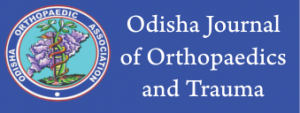Characteristic of foot morphology and their relationship to gender, Age, Body mass index and bilateral asymmetry in Indian adults with normal and symptomatic foot
Vol 01 | January 2020 | page: 7-10 | A C Agrawal, Bikram K Kar, Harshal Sakale, Sandeep, Rakshit J
DOI- 10.13107/ojot.2020.v41i01.004
Authors: A C Agrawal [1], Bikram K Kar [1], Harshal Sakale [1], Sandeep [1], Rakshit J [1]
[1] Department Of Orthopaedics, AIIMS Raipur Chattisgarh, India.
Address of Correspondence
Dr. Rakshit J,
AIIMS Raipur Chattisgarh, India.
E-mail: jgrakshit@gmail.com
Abstract
Introduction: The human foot, the foundation for bipedal locomotion, is a complex adaptation that evolved through extensive remodelling of the hind appendage of our arboreal primate forebears (Susman 1983).Different characteristics of foot morphology are commonly accompanied by altering lower extremity biomechanical characteristics and foot function. Clarifying what factors affect foot morphology is helpful in understanding the basis of foot deformity and foot dysfunction. As the direction of change in foot morphology caused by ageing can be assumed theoretically, it should be possible to judge whether ageing or secular changes are more important in determining the foot morphology of Indian adults.
Aims: The aim of this study was to investigate characteristics of foot morphology and whether related factors such as gender, age, body mass index (BMI) and bilateral asymmetry have an impact on foot morphology.
Material and Methodology and Implications: The present study is planned in the Department of Orthopaedics, AIIMS Raipur CG. One hundred asymptomatic adults were included in this cross-sectional study. Participants will be categorised by gender, age, BMI and left and right foot respectively to compare foot morphology differences. The characteristics of foot morphology are measured by taking measurements, foot prints on graph paper, photographs Fig 1. All measurements were done by one person to avoid error that could be caused by individual differences or any discomfort. The parameters obtained from the participants include: age, gender, foot length, foot breadth and foot height of the subjects
Result: Symptomatic foot population were overweight compared to asymptomatic population and hence forth had a higher BMI .Mean arch height was lower with mean of 3.5224 in symptomatic foot compared to asyptomatic foot that was 3.9663.Mean arch height index in right foot – weight bearing was 0.2492 compared to non weight bearing foot that was 0.2312
Conclusion: Using arch index values obtained from imprint over paper to classify foot type as high arched ,normal , low arched ,based on defined ranges gives an idea about the cause of foot pathology and also the socio- demographical parameters responsible for foot morphology.
Keywords: Foot Morphology, Symptomatic foot, BMI.
References
1. William Ledoux, Ph.D. , Eric Rohr, M.S. , Randy Ching, Ph.D. , Bruce Sangeorzan, M.D RR&D Centre of Excellence for Limb Loss Prevention and Prosthetic Engineering, VA Puget Sound Heath Care System, Seattle, and Department of Medical Engineering, University of Washington 98108, USA. wrledoux@u.washington.edu
2. M Mauch, S Grau, I Krauss, C Maiwald and T Horstmann, Department of Sports Medicine, Medical Clinic, University of Tuebingen, Tuebingen, Germany.
3. Zhao X1, Tsujimoto T2, Kim B1, Katayama Y3, Tanaka K2. 1- Doctoral Program in Sports Medicine, Graduate School of Comprehensive Human Sciences, University of Tsukuba, Ibaraki, Japan. 2- Faculty of Health and Sports Sciences, University of Tsukuba, Ibaraki, Japan. 3- Faculty of Education, Kogakkan University, Mie, Japan.
4. Ann Hallemans, Lic; Kristiaan D’Aouˆt, Ph.D.; Dirk De Clercq, Ph.D.; Peter Aerts, Ph.D.∗Antwerp, Belgium. The Laboratory for Functional Morphology, Department of Biology, University of Antwerp, Antwerp, Belgium. The Laboratory for Movement and Sport Sciences, University of Ghent, Belgium.
5. Singla R, Associate Professor *, Biswas M, Formerly MSc Student, * Bedi M, Professor *, Bedi S. Professor, ***Department of Anatomy, MMIMSR Mullana, Ambala, Haryana, India. ** Department of Pathology, MMIMSR Mullana, Ambala, Haryana, India.
6. DANIEL M. T. FESSLER1, KEVIN J. HALEY1 & ROSHNI D. LAL2. 1 Center for Behavior, Evolution, and Culture and Department of Anthropology, UCLA, Los Angeles, CA 90095-1553, USA and 2 Dewitt Stetten, Jr Museum of Medical Research, National Institutes of Health, Bethesda, MD 20892-2092, USA, and Smithsonian Center for Education and Museum Studies, Washington, DC 20013-7012, USA.
7. López-López D, Vilar-Fernández JM, Barros-García G, et al. Foot Arch Height and Quality of Life in Adults: A Strobe Observational Study. Int J Environ Res Public Health. 2018;15(7):1555. Published 2018 Jul 23. doi:10.3390/ijerph15071555
8. Matthew Hill, Roozbeh Naemi, Helen Branthwaite, Nachiappan Chockalingam, The relationship between arch height and foot length: Implications for size grading, Applied Ergonomics, Volume 59, Part A,2017,
9. Nagano K, Okuyama R, Taniguchi N, Yoshida T. Gender difference in factors affecting the medial longitudinal arch height of the foot in healthy young adults. J PhysTher Sci. 2018;30(5):675–679. doi:10.1589/jpts.30.675.
| How to Cite this Article: Agrawal A C, Bikram K K, Sakale H, Sandeep, Rakshit. | Characteristic of foot morphology and their relationship to gender, Age, Body mass index and bilateral asymmetry in Indian adults with normal and symptomatic foot. | Odisha Journal of Orthopaedics and Trauma | January 2020; 01: 7-10.
DOI- 10.13107/ojot.2020.v41i01.004 |
(Abstract Text HTML) (Download PDF)
.


